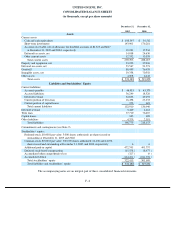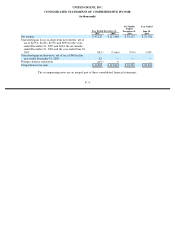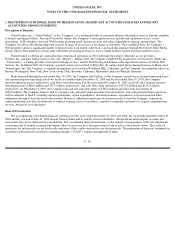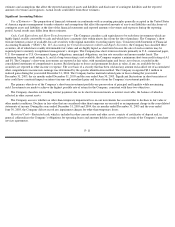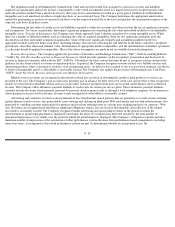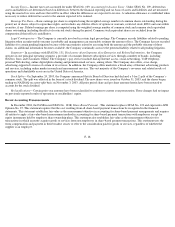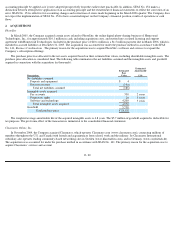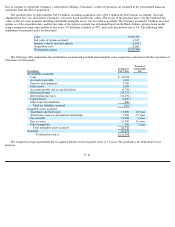Classmates.com 2005 Annual Report Download - page 82
Download and view the complete annual report
Please find page 82 of the 2005 Classmates.com annual report below. You can navigate through the pages in the report by either clicking on the pages listed below, or by using the keyword search tool below to find specific information within the annual report.
The Company assesses the impairment of long-lived assets, which include property and equipment and intangible assets, whenever events
or changes in circumstances indicate that such assets might be impaired and the carrying value may not be recoverable in accordance with SFAS
No. 144,
Accounting for the Impairment or Disposal of Long-Lived Assets . Events and circumstances that may indicate that an asset is impaired
include significant decreases in the market value of an asset, significant underperformance relative to expected historical or projected future
results of operations, a change in the extent or manner in which an asset is used, significant declines in the Company’
s stock price for a sustained
period, shifts in technology, loss of key management or personnel, changes in the Company’s operating model or strategy and competitive
forces.
If events and circumstances indicate that the carrying amount of an asset may not be recoverable and the expected undiscounted future cash
flows attributable to the asset are less than the carrying amount of the asset, an impairment loss equal to the excess of the asset’s carrying value
over its fair value is recorded. Fair value is determined based on the present value of estimated expected future cash flows using a discount rate
commensurate with the risk involved, quoted market prices or appraised values, depending on the nature of the assets.
Goodwill— The Company adopted SFAS No. 142, Goodwill and Other Intangible Assets , on July 1, 2002. Under SFAS No. 142, goodwill
is not amortized, but is tested for impairment at a reporting unit level on an annual basis and between annual tests if an event occurs or
circumstances change that would more likely than not reduce the fair value of a reporting unit below its carrying amount. Events or
circumstances which could trigger an impairment review include a significant adverse change in legal factors or in the business climate, an
adverse action or assessment by a regulator, unanticipated competition, a loss of key personnel, significant changes in the manner of the
Company’s use of the acquired assets or the strategy for the Company’s overall business, significant negative industry or economic trends,
significant declines in the Company’s stock price for a sustained period or significant underperformance relative to expected historical or
projected future results of operations.
The Company determines reporting units by allocating assets, including goodwill, based on its related service offerings. In testing for a
potential impairment of goodwill, the estimated fair values of the Company’s reporting units are compared with their respective book values,
including goodwill. If the estimated fair value exceeds book value, goodwill is considered not to be impaired and no additional steps are
necessary. If, however, the fair value of the reporting unit is less than book value, then the carrying amount of the goodwill is compared with its
implied fair value. The estimate of implied fair value of goodwill may require independent valuations of certain internally generated and
unrecognized intangible assets such as the Company’s pay account base, software and technology and patents and trademarks. If the carrying
amount of goodwill exceeds the implied fair value of that goodwill, an impairment loss would be recognized in an amount equal to the excess. In
accordance with SFAS No. 142, the Company performed a goodwill impairment test during the December 2005 quarter and concluded that, at
that time, there was no impairment of goodwill.
At December 31, 2005, goodwill recorded on the Company’s books totaled $80.5 million. Goodwill increased by $76.5 million and $4.0
million during the years ended December 31, 2004 and 2005, respectively, as a result of acquisitions (see Note 2). The Company recorded a
reduction in goodwill of $9.5 million during the December 2004 quarter in connection with the release of the deferred tax valuation allowance
(see Note 3).
Business Combinations— All of the Company’s acquisitions have been accounted for as purchase business combinations. Under the
purchase method of accounting, the cost, including transaction costs, is allocated to the underlying net assets, based on their respective estimated
fair values. The excess of the purchase price over the estimated fair values of the net assets acquired is recorded as goodwill.
F- 13



